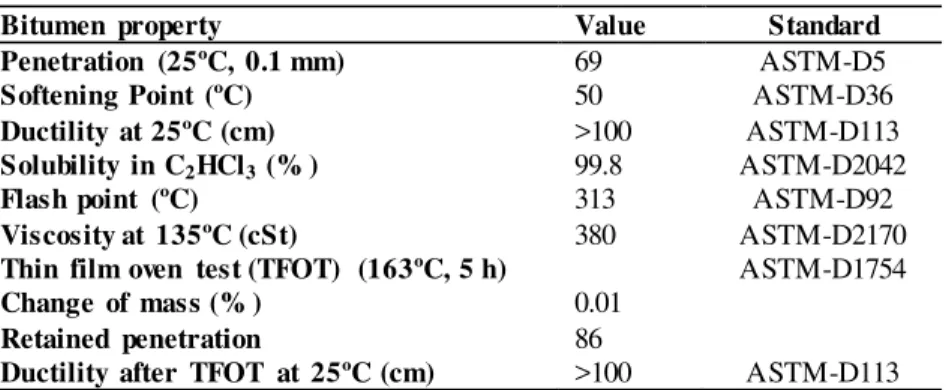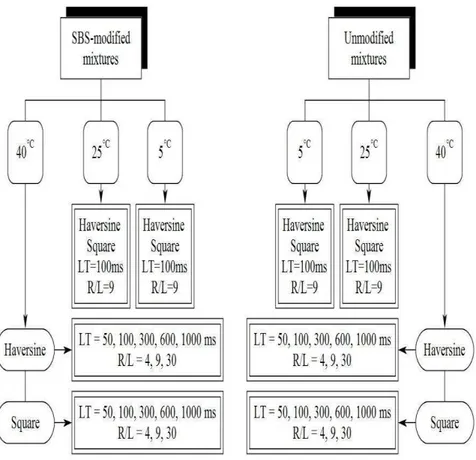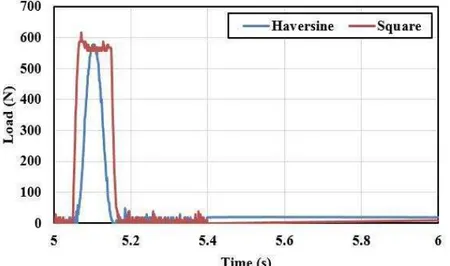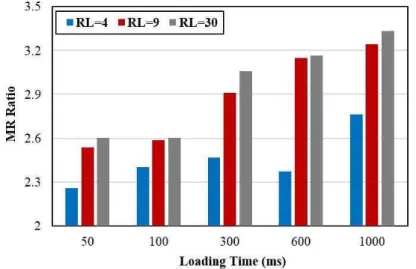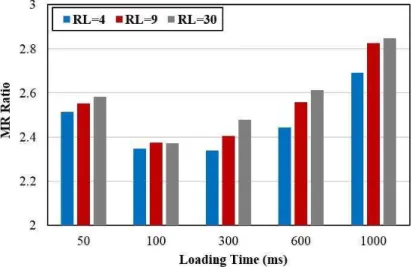© School of Engineering, Taylor’s University
EFFECTS OF STYRENE-BUTADIENE-STYRENE ON
STIFFNESS OF ASPHALT CONCRETE AT DIFFERENT
TRAFFIC CONDITIONS
GHOLAMALI SHAFABAKHSH, AMIN TANAKIZADEH*
Faculty of Civil Engineering, Semnan University, Semnan, Iran *Corresponding Author: atanakizadeh@semnan.ac.ir
Abstract
The previous studies have explored the effects of Styrene-Butadiene-Styrene (SBS) as the most prevalent modifier for asphalt mixtures. The current study intends to compare stiffness modulus of control and SBS modified asphalt mixtures under different traffic loadings. To this end, resilient modulus tests were performed on both conventional and SBS modified specimens. Tests were conducted at 5, 25 and 40°C with loading times of 50, 100, 300, 600 and 1000 milliseconds and 4, 9 and 30 as ratio of rest periods (between loading pulses) to loading times (R/L). Using these test parameters and haversine and square loading pulses that rep resent vertical stress distribution at different depths within an asphalt layer, a variety of traffic densities and vehicle speeds were simulated and their effects on stiffness of asphalt concrete were determined. Results indicated that SBS modification provide higher stiffness under haversine pulse with long loading time at 40°C, so that it was about 3 times of unmodified mixture stiffness. The effect of traffic density that represented by R/L was significant only in long loading time (1000 ms) especially under haversine pulse.
Keywords: Flexible pavements, Asphalt concrete, Stiffness, SBS, Traffic loading.
1.
Introduction
properties required are elastic modulus and Poisson's ratio. Previous e xperience and the available literature have demonstrated that the elastic modulus has a much more significant impact on M-E analysis and predicted distresses [1].
The resilient modulus is elastic modulus that is used with elastic theory. If load is s ma ll co mpared to strength of the materia l and is repeated for a large number o f t imes, a ll of deformat ion under each load repetition is appro ximately
Nomenclatures
C2HCl3 Trichloroethylene (Table 3)
D Diameter of specimen, mm
Gmb Maximum gravity of compacted asphalt mixture, kg/m3
Leff Effective length, in
MR Resilient Modulus , MPa
ms Milliseconds
P Maximum applied load or repeated load, N St Indirect tensile strength, KPa
t Time of loading, sec (Eq. (2)); Height of specimen, mm (Eq.(6)) Va Air void, in percent
vs Velocity, mph
Zeff Effective depth, in
Greek Symbols
ΔH Recoverable horizontal deformation, mm εr Recoverable strain
σd Deviator stress, MPa
ν Poisson’s ratio
Abbreviations
AASHTO American Association of State Highway and Transportation Officials
ASTM American Society for Testing and Materials
CR Crumb Rubber
EVA Ethylene Vinyl Acetate HMA Hot Mix Asphalt ITS Indirect Tensile Stress LA Los Angeles (Table 2) LL Liquid Limit (Table 2) LT Loading Time (Fig. 2) M-E Mechanistic-Empirical PI Plastic Index (Table 2) PL Plastic Limit (Table 2)
R/L Rest period to Loading time ratio rpm Rotation per minute
SBS Styrene Butadiene Styrene SMA Stone Mastic Asphalt
recoverable and can be considered elastic. At the init ial stage of load applications, there is considerable permanent deformat ion, as considered plastic strain. As the number of repetit ions increases, the plastic strain caused by each load re petition decreases [2]. After 100 to 200 repetit ions, strain is practically a ll recoverable, as indicated by (εr). The elastic modulus based on recoverable strain under repeated
loads is called resilient modulus (MR), defined as Eq. (1) [2]:
d
r MR
(1)
where MR is resilient modulus (MPa ), σd is deviator stress (MPa) and εr is
recoverable strain (dimensionless).
Asphalt concrete is a viscoelastic materia l and its resilient modulus is both temperature and loading time dependent. Therefore, both te mperature and loading time must be known in order to select a reasonably appropriate modulus for these materia ls. Additionally, there is another important aspect, rest period, and its effect on stiffness that is studied in th is paper. As noted previously, asphalt concrete mechanical responses are time dependent; consequently, it is equally significantly influenced by the rest periods that occur between field traffic loads due to different traffic densities.
The resilient modulus that represents stiffness properties of asphalt concrete has a key role in design of fle xib le pave ments and determination of performance related fa ilures. With rap id increase in the number of vehicles and overloading trucks, pre mature distresses in asphalt pavements have increased. Then, researchers decided to improve stiffness characteristics of asphalt mixtures by incorporating additives such as polymers and rubbers. Unsaturated thermoplastic elastomers like styrene–butadiene–styrene (SBS) b lock copolyme rs are probably the most commonly used polymers. They enhance asphalt’s elastic recovery capacities and, therefore, its resistance to permanent defo rmat ions [3]. The SBS modifier forms a lattice in binder, which provides the desired properties of elasticity, plasticity, and elongation. Therefore, SBS-modified asphalts tend to improve the adhesive property of mix, fatigue and rutting resistance, low temperature flexibility, and resistance to bleeding [4].
Many researches have studied the effects of SBS modification on asphalt binders and mixtures. These studies have evaluated the various properties of asphalt materia ls related to performance of fle xib le pave ments in different conditions. Airey [5] studied polyme r modification of road bitumen with SBS. The results of the investigation indicated that degree of SBS modification was a function of bitu men source, b itumen-poly me r compatib ility and poly me r concentration. The ag ing resistance of SBS mod ified asphalt was superior to base asphalt because of effect of SBS modifier [6].
In a study by Chen et al. [8] SBS copoly mer was blended with asphalt binders to investigate the effect of SBS modificat ion on asphalt binder properties. Appearance of a continuous polymer structure was observed to begin at a SBS content of about 5%. A change of regime of the softening point and penetration profiles was seen at SBS we ight concentration around 5%. The phase inversion appeared to occur when the SBS gradually beca me the continuous matrix phase. This suggests that a content that is slightly higher than the phas e inversion content (5%) is the optimum content for SBS modification [8].
The effects of modification, mixture grad ing, and binder content on the linear viscoelastic limits and rheological characteristics of bitu minous binders and asphalt mixtures we re ascertained. In terms of modification, only the elastomeric SBS mod ified bitu men showed any significant differences in linearity limits and rheological properties co mpared to conventional materials, while the effect of mixtu re grading and binder content only lead to minor diffe rences among the asphalt mixtures [9].
Ku mar et al. [10] investigated strength characteristics of polymer -modified mixes. The SBS modified mixes had 1.2–1.9 t imes higher modulus values as compared to those of the unmodified mix. In another study, two different aggregate including limestone and basalt, and three SBS contents (3, 5, and 7%) were used for the asphalt mixtures. The specimens prepared with limestone e xhibited higher stiffness than basalt specimens did. For both mixtures, the resilient modulus values were increased while SBS content increased [3].
Ping and Xiao [11] evaluated the SBS modified b inder effect on resilient modulus properties of Flo rida asphalt mixtures. They found that the SBS poly me r modifier made the HMA mixture softer at mid to lo w test temperatures and ma intained stiffness level at high te mperatures. An effective SBS poly mer content appeared to exist between 3.0% and 6.0% depending on the actual conditions of mixture production.
Awanti et al. [12] showed that the static indirect strength values for SBS modified asphalt concrete were higher in order of 49 -101% when compared to conventional asphalt mixtu res in the temperature range of 15-40°C. The viability of using SBS as an additive in stone mastic asphalt (SMA) was investigated in another study. The mixture mod ified with 5% SBS showed higher stability and tensile strength, lower moisture susceptibility and about 40% increase in resilient modulus values at 25°C [13]. Singh et al. [14] reco mmended the 5% SBS content for better strength and moisture susceptibility. The use of SBS modified bitu men is recommended to be more benefic ial with siliceous or aggregates exhibiting acidic character compared to calcareous aggregates.
The superior effects of SBS poly mer on asphalt mixtures in terms of rutting and cracking resistance, stability, load spreading capacity, co mpactibility and ability of mix to absorb energy and deform without fracturing we re investigated in the other literatures [15, 16, 17, 18, and 19].
and SBS mod ified asphalt mixtures using indirect tensile resilient modulus test under different loading conditions. Application of two different loading pulse, five loading t imes, and three rest to load ratios (R/ L) that de monstrate different traffic loading conditions differentiates this study from other ones .
2.
Experimental Procedures
2.1.
Mate rials
The asphalt samples we re fabricated using granite aggregates. The aggregate gradation of asphalt mixtures was selected based on grading No.4 (0-19 mm), according to Iran Highway Asphalt Code [20]. This grading can be used for constructing surface and binder asphalt layers. The gradation specifications and physical properties of the aggregates are summa rized in Tab les 1 and 2, respectively.
Table 1. Gradation specifications of aggregates.
Sieve Size (mm)
Standard Limits (% )
Passing from Sieve (% )
19 100 100
12.5 90-100 95
4.75 (#4) 44-74 58
2.36 (#8) 28-58 43
0.3 (#50) 5-21 13
0.075 (#200) 2-10 6.4
Table 2. Physical properties of aggregates .
Aggregate property Standard Fraction
Coarse Fine Filler LA abrasion loss (% ) ASTM-C131 18 - - Sodium sulphate soundness (% ) ASTM-C88 1.3 7.1 - Sand equivalent (% ) ASTM-D2419 - 72 -
Flakiness (% ) ASTM-D4791 12 - -
Crushed in one face (% ) ASTM-D5821 96 - -
Plastic Index (PI) ASTM-D4318 - NP 8
Plastic Limit (PL) ASTM-D4318 - - 18
Liquid Limit (LL) ASTM-D4318 - - 26
Table 3. Properties of base bitumen.
Bitumen property Value Standard
Penetration (25ºC, 0.1 mm) 69 ASTM-D5
Softening Point (ºC) 50 ASTM-D36
Ductility at 25ºC (cm) >100 ASTM-D113
Solubility in C2HCl3 (% ) 99.8 ASTM-D2042
Flash point (ºC) 313 ASTM-D92
Viscosity at 135ºC (cSt) 380 ASTM-D2170
Thin film oven test (TFOT) (163ºC, 5 h) ASTM-D1754
Change of mass (% ) 0.01
Retained penetration 86
Ductility after TFOT at 25ºC (cm) >100 ASTM-D113
Table 4. SBS polymer properties [21].
Polymer properties Value Standard
Structure Linear -
Toluene solution viscosity 25% (Pa-s) 5 MA 04-3-064 Toluene solution viscosity 5.23% (cSt) 13 MA 04-3-003
Volatile matter (% ) 0.4 ASTM-D5668
Hunterlab colour 2 ASTM-D1925-70
Total styrene (on polymer) (% ) 31 ASTM-D5775
Hardness (°Shore A) 76 ASTM-D2240
Insoluble in Toluene (325 mesh) (% ) < 0.1 MA 04-3-018
Ashes (% ) < 0.35 ASTM-D5669
Fig. 1. Compacte d asphalt mixture specimens .
2.2.
Mix design
type and gradation was used in order to evaluate the influence of the SBS modification on the resilient modulus of asphalt mixes, specifically.
Table 5. Mix design results.
Bitumen content (% )
Gmb
(Kg/m3) Va (% ) VMA (% ) VFA (% ) Stability (Kg) Flow (0.25mm)
4 2205 8.6 16.15 46.8 841 10.15
4.5 2226 7.1 15.7 55.2 889.5 10.7
5 2246 5.7 15.45 63.7 955.5 11.2
5.5 2269 4.1 15.1 72.95 1045 11.85
6 2277 2.85 15.2 81.1 959 12
2.3.
Resilient modulus test
Since the magnitude of applied load in MR test should be selected as a portion of indirect tensile strength (ITS) of asphalt mix, the indirect tensile strength of both unmodified and SBS mod ified were measured [23 , 24]. The static indirect tensile strength of a given specimen was determined usin g the procedure outlined in ASTM-D6931 [25] at te mperature of 25°C and loading rate of 50 mm/ min. The load is applied and the failure load is noted from the dial gauge of the proving ring.
In this study, the resilient modulus of asphalt concrete samples wa s determined using the indirect tension method in accordance with AA SHTO-TP31 standard [23] using UTM-14P device (Fig. 2). After 100 cycles of preconditioning, the final resilient modulus was co mputed according to the average of resilient modulus at five last loading cycles.
Resilient modulus test was conducted at three different te mperature of 5, 25, and 40oC for both unmodified and modified asphalt specimens. The minimu m allo wable loading time, which could be applied by UTM device, was 50 ms. According to common testing protocols [23 and 24] for determin ing the resilient modulus, the loading time and R/ L have been proposed to be sequentially 100 ms and 9 under haversine loading pulses.
Some researchers showed that the shape and duration of loading in asphalt layer varies with respect to vehicle speed, asphalt thickness, depth and the ratio of asphalt layer modulus to base layer modulus [3]. They showed that the loading shape near the asphalt surface can be represented by square shape, and by increasing the depth the loading shape approaches to haversine or triangle shape.
Fig. 2. UTM 14P for resilient modulus test.
3.
Theory
3.1.
Dete rmination of loading times
In M-E pavement design guide the following relationship relates the time of load to the vehicle speed (velocity) and the effective length of the pulse (Eq. (2)) [26].
17.6
eff
s L t
v
(2)
where t is time o f load (sec), Leff is effective length (inch) and vs is velocity (mph).
The effect ive length is the length that defines the e xtent of the stress pulse at a specified depth within pavement system. For any pave ment layer the effective length of stress pulse is computed at a specific depth for computation of the modulus. This depth is transformed depth and is termed as effective depth (Zeff).
The effective depth is computed by the following relationship (Eq. (3)) [26]:
1
3 3
1
n
i n
eff i n
i SG SG
E E
Z h h
E E
(3)where Ei is the modulus of ith layer (MPa), ESG is the modulus of subgrade (MPa)
hn is the thickness of the layer of interest (layer n) at which the computation is
In this study the effective depth is computed at the mid -depth of the first layer (n=1 for asphalt concrete layer). It is appro ximately co rrect that no overlap occurs between axles at mid-depth of first layer since the effective depth is smalle r than the free distance between axles. There fore, the effective length is defined by the Eq. (4) [26]:
2
eff c eff
L a Z (4)
where ac is the rad ius of contact area (in). Assumptions and computed effective
depth and length for this study are shown in Table 6.
Fig. 3. Diagram of experiments .
Table 6. Assumptions and computed parameters.
ac (in) E1 (MPa) ESG (MPa) h1 (in) Zef f (in) Lef f (in)
3.5 3000 50 8 15.65 38.3
3.2.
Computation of ITS
In indirect tensile strength test, the ITS values can be determined by Eq. (5) [25]:
2000
t
P S
t D
(5)
where St is the indirect tensile strength (kPa ), P is the ma ximu m applied load (N),
t is the height of specimen (mm), and D is the dia meter of specimen (mm). The ITS values of asphalt mix sa mp les prepared by unmodified and SBS -modified bitumen were determined as 792.5 and 982.5 kPa, respectively.
3.3.
Computation of MR
In Resilient modulus test based on AASHTO-TP31 standard, the ma ximu m applied load at te mperature of 5, 25, and 40oC assumed as 30, 15 and 5 percent of indirect tensile strength of asphalt mixture at te mperature of 25oC [23]. Resilient modulus in indirect tensile method can be computed using Eq. (6) [24]:
0.27
P MR
t H
(6)
where MR is the resilient modulus (MPa), P is the repeated load (N), ν is Poisson's ratio, t is the thickness of specimen (mm), and ΔH is the recoverable horizontal deformation (mm). The Poisson's ratio in Eq. (6) was selected according to the test temperature. The Po isson's ratio at three te mperatures of 5, 25, and 40oC was determined based on M-E pavement design guide as 0.2, 0.35, and 0.4, respectively [26]. The difference between haversine and square pulses in terms of load and displace ment curves at 40oC a re presented in Figs. 4 and 5, consecutively.
Fig. 4. Difference between haversine and square load pulses (100 ms, R/L=9).
4.
Results and Discussion
of SBS modification on resilient moduli of asphalt mixtures in diffe rent cases, the MR ratios are obtained by dividing the MR of modified mixture to MR of unmodified mixture at the same conditions.
Fig. 5. Difference between deformations under haversine and square loadings (100 ms, R/L=9).
Figure 6 shows how the SBS modificat ion alters the resilient modulus of mixtu res at different te mperatures under standard loading conditions (100ms, R/L=9).
Fig. 6. MR ratios at different temperatures (loading time=100 ms, R/L=9).
deformations occurred in the mixture and increases its modulus. This confirms the results of other studies [12, 16 and 18] re lated to superior performance of SBS modified mixtures in h igh te mperature rutting resistance. A same mechanis m occurs at 5°C, but in th is case, the mixture behaviour is quasi-elastic and strengthening effect of polymer network is less apparent.
The low MR ratio at 5°C is benefic ial to facilitate d issipation of induced loads and high MR ratio at 40°C is convenient to prevent from viscous behaviour of the mixtu re. In addit ion, the proper content of polyme r (5%) and bitumen -poly me r compatibility made a continuous elastic network in the mixtu re that increased the stiffness of the SBS modified samp le. Since the d ifferences in MR values are more obvious at 40°C, in the rest of study, the results are co mpared in different loading conditions and at temperature of 40°C.
Figure 7 illustrates the MR ratios in various traffic densities and axles’ distances using three R/ L values of 4, 9, and 30 and with standard loading time of 100 ms. The R/L had no considerable e ffect on MR ratios, especially in case of square loading. The results confirm the s mall e ffects of R/ L on MR rat ios that have been stated in another study [27].
Fig. 7. MR ratios in different rest to load ratios (R/L) at 40°C (loading time=100 ms).
As shown in Fig. 8, the effects of SBS modification on stiffness of asphalt concrete become more obvious with increase in loading times so that MR ratio e xceeds 3. Th is finding was more significant under haversine loading, because the haversine pulse simulates the stresses in higher depths of asphalt layer that e xperience the longer loading times than shallow depths. In other words, the polymer modifie r had a great impact on the viscous or time dependent characteristics of asphalt concrete that agree with the findings of oth er researchers [15].
Fig. 8. MR ratios in different loading times at 40°C (R/L = 9).
Figures 9 and 10 depict the results re lated to haversine and square pulses, respectively. According to Fig. 9, the effects of SBS modifie r was more considerable in long loading times and the diffe rences between MR ratios in diffe rent R/L’s for each of loading times were more significant when changed fro m 4 to 9. The increase in R/ L resulted in greater recoverable strains and less MR values for unmodified mixtures. On the other hand, the modified mixes kept their stiffness and MR ratios increased. Changing the R/L fro m 9 to 30 e xh ibited no apparent difference a mong MR rat ios that coincide with another study [28]. Because of mo re time for strains to recover, the d iffe rences between MR ratios with R/L equal to 4 and 9 were more evident in case of long loading times.
Fig. 9. Comparison of MR ratios under haversine pulse in different loading times and R/Ls at 40°C.
time of 50 ms is slightly mo re than 100 and 300 ms that can be due to different arrangement o f aggregates in specimens during co mpaction. This phenomenon may change the level of strength provided by aggregate skeleton and lead to different modulus (Fig. 10).
Fig. 10. Comparison of MR ratios under square pulse in different loading times and R/Ls at 40°C
5.
Conclusions
In this paper, the stiffness characteristics of SBS modified asphalt concrete under diffe rent traffic loadings including vehic le speed and traffic density was evaluated. The fo llo wing a re a summary of findings based on the results obtained in the present study:
As it is e xpected, the MR of mod ified mixtu res was considerably more than control ones, especially at high temperature (40°C) with MR ratios about 2.5. The different traffic densities as well as axle’s distances were considered using three R/ L values of 4, 9, and 30. The results showed the slight changes in MR ratios by altering the R/L values in common loading time of 100 ms. The effects of SBS modification on MR of asphalt concrete became mo re
obvious with increase in loading times so that MR ratio e xceeded 3 under 1000 ms haversine loading. The SBS modificat ion can be more effective in slow vehicle speeds. The interaction impacts of loading times and R/L’s for both haversine and square pulses indicated the diffe rences between MR rat ios in different R/L’s for each of loading times were more significant when changed fro m 4 to 9. The diffe rence between MR rat ios in R/L values of 4 and 9 were greater in long loading times.
beneficiary to incorporate in deeper asphalt layer (i.e. binder layer) mixture than near surface mat.
In the scope of this study, we can conclude that the stiffness properties of SBS modified asphalt concrete should be evaluated more comprehensive at high temperatures and under haversine pulse with long loading times. The future studies may be conducted on SBS modified asphalt mixtures prepared using a variety of aggregates and binders.
References
1. Hu, S.; Zhou, F.; Hu, X.; Scu llion, T.; Qi, X.; Walubita, L.F.; and Claros, G. (2008). Consideration of HMA resilient modulus (Mr) for M E pave ment design and analysis. Journal of the Association of Asphalt Paving Technologists, 77, 663-708.
2. Huang, Y.H. (2004). Pavement analysis and design (2nd Ed ition), Prentice Hall, New Jersey, USA.
3. Kok, B.V.; and Ku loglu, N. (2008). Investigation of Mechanical Properties of Asphalt Concrete Containing Styrene Butadiene Styrene. Sigma Journal of Engineering and Natural Sciences, 26 (1), 81-94.
4. Roque, R.; Birgisson, B.; Dra kos C.; and Sholar, G. (2005). Guidelines for Use of Modified Binders. Depart ment of Civil and Coastal Engineering, University of Florida, Gainesville, FL, USA.
5. Airey, G.D. (2004). Styrene butadiene styrene polymer mod ification of road bitumens. Journal of Materials Science, 39(3), 951–959.
6. Sun, L.; Wang Y.; and Zhang, Y. (2014). Aging mechanism and effective recycling rat io of SBS modified asphalt. Construction and Building Materials, 70, 26-35.
7. Ku mar, P.; Mehndiratta H.C.; and Singh, K.L. (2010). Journal of Materials in Civil Engineering, 22(10), 978-984.
8. Chen, J.S.; Liao M .C.; and Sh iah, M.S. (2002). Asphalt Modified by Styrene-Butadiene-Styrene Tribloc k Copoly mer: Morphology and Model. Journal of Materials in Civil Engineering, 14(3), 224-229.
9. Airey, G.D.; Rahimzadeh B.; and Collop, A.C. (2004). Linear Rheologica l Behavior of Bituminous Paving Materials. Journal of Materials in Civil Engineering, 16(3), 212-220.
10. Ku mar, P.; Chandra S.; and Bose, S. (2006). Strength characteristics of polymer modified mixes. The International Journal of Pavement Engineering, 7(1), 63-71.
11. Ping, W.V.; and Xiao, Y. (2011). Eva luation of SBS Po ly mer Binder Effect on Resilient Modulus Properties of Florida HMA Mixtu res. Proceedings of the 24th ICTPA Annual Conference & NACGEA International Symposium on Geo-Trans, May 27-29, ICTPA and NACGEA, Los Angeles, Californ ia, USA.
13. Al-Had idy, A.I.; and Yi-qiu, T. (2011). Effect of Styrene-Butadiene-Styrene on the Properties of Asphalt and Stone-Matrix-Asphalt Mixture. Journal of Materials in Civil Engineering, 23(4), 504-510.
14. Singh, M.; Ku mar, P.; and Maurya, M.R. (2013). Strength characteristics of SBS mod ified asphalt mixes with various aggregates. Construction and Building Materials, 41, 815-823.
15. Birgisson, B.; Montepara, A.; Ro mero, E.; Roque R.; and Tebaldi, G. (2007). The effect of SBS asphalt modifier on hot mix asphalt (HMA) mixture cracking resistance. Proceedings of the fourth International SIIV Congress on Advances in Transport Infrastructures and Stak eholders Expectations, Sep. 12-14, Palermo, Italy.
16. Sengul, C.E.; Oruc, S.; Iskender E.; and Aksoy, A. (2013). Evaluation of SBS modified stone mastic asphalt pavement performance. Construction and Building Materials, 41, 777-783.
17. Modarres, A. (2013). Investigating the toughness and fatigue behavior of conventional and SBS modified asphalt mixes. Construction and Building Materials, 47, 218-222.
18. Khodaii, A.; and Mehrara, A. (2009). Eva luation of permanent deformat ion of unmodified and SBS modified asphalt mixtures using dynamic creep test. Construction and Building Materials, 23, 2586-2592.
19. Kim, T.W.; Beak, J.; Lee H.J.; and Choi, J.Y. (2013). Fatigue performance evaluation of SBS modified mastic asphalt mixtu res. Construction and Building Materials, 48, 908-916.
20. Iran Vice-Presidency for Strategic Planning and Supervision, (2011). Iran Highway Asphalt Paving Code. Iran Management and Planning Organizat ion Press, Tehran, Iran.
21. Dynasol, (2014). CALPRENE® 501 Thermoplastic Rubber Styrene- Butadiene-Styrene Bloc k Copoly mer Technica l Data Sheet. Retrieved
September 24, 2014, fro m
http://www.dynasolelastomers.com/cms/uploads/htcal-0501-ing-aug-01.pdf. 22. AASHTO, (2008). Standard method of test for resistance to plastic flow of
bituminous mixtures using Marshall apparatus, AASHTO Designation: T245-97. A merican Association of State Highway and Transportation Officials, Washington DC, USA.
23. AASHTO, (1996). Standard test method for determining the resilient modulus of bituminous mixtures by indirect tension, AASHTO Designation: TP31. A me rican Association of State Highway and Transportation Offic ials, Washington DC, USA.
24. ASTM, (2011). Standard test method for determining the resilient modulus of bituminous mixtures by indirect tension test, ASTM standard D7369. ASTM International, West Conshohocken, PA.
25. ASTM, (2007). Standard test method for indirect tensile (IDT) strength of bituminous mixtures, ASTM standard D6931. ASTM International, West Conshohocken, PA.
Cooperative Highway Research Progra m, Transportation Research Board, Washington, USA.
27. Barksdale, R.D.; Alba, J.; Khosla, N.P.; Kim, R.; La mbe, P.C.; and Rah man, M.S. (1997). NC HRP Web Doc 14: Laboratory Determination of Resilient Modulus for Flexible Pavement Design. The Nat ional Academies Press, Washington, USA.

